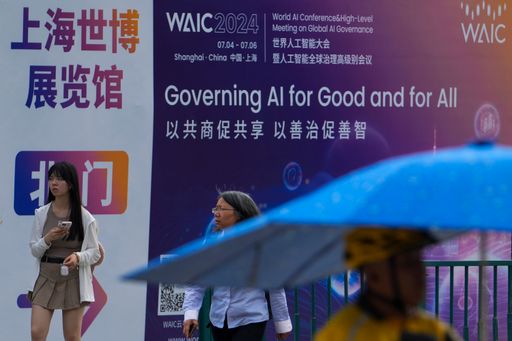This exclusivity-focused approach stems from the belief that protecting proprietary advantages is essential for maintaining commercial leverage and strategic superiority.
China’s ‘openness’ strategy
Beijing responded to Washington’s action plan with one of its own, emphasising international cooperation in both development and regulation.
Warning against AI becoming an “exclusive game” controlled by a few nations and corporations, China positioned itself as the champion of openness.
China’s Global AI Governance Initiative has pledged to expand open-source development and share capabilities with developing countries, particularly in the Global South, as well as to promote multilateral governance through a new international body headquartered in Shanghai.
These initiatives are intended not only to institutionalise China’s leadership role but also to bring global rules, standards, and norms more closely into alignment with its strategic interests.
Two objectives underpin this openness.
First, by releasing advanced open-source models, Beijing is contesting the US approach of monetising AI as an exclusive, proprietary product. If these open-source platforms achieve the same level of performance as their US counterparts, the commercial advantage of exclusivity — one of Washington’s key competitive assets — could be significantly diminished.
Second, by enabling these models to be freely adapted and exported, China embeds its technology in the digital infrastructure of emerging economies. This creates long-term dependencies and gives Beijing greater leverage over global technical standards and governance frameworks.
Who will dominate AI sovereignty?
Recent advances by Chinese AI firms are closing the performance gap with the US, raising the prospect of a world in which American dominance is no longer guaranteed — and in which Chinese models could be adopted on a par with, or even more widely than, those in the US.
In such a scenario, the contest would shift from technical superiority to control over the standards, ecosystems, and governance models embedded in global digital infrastructure.
As Microsoft President Brad Smith warned, “The No. 1 factor that will define whether the US or China wins this race is whose technology is most broadly adopted in the rest of the world. Whoever gets there first will be difficult to supplant.”
Beijing’s centralised, state-led model enables it to mobilise resources, align industry and exploit disruptive opportunities far more quickly than the US’s private-sector–driven approach. This agility could put Washington in a paradoxical position: technologically advanced, yet strategically outmanoeuvred.
For middle powers and emerging economies, the stakes are no less acute. Both Washington and Beijing export not just products but technological ecosystems that carry political influence.
Alignment with either superpower risks long-term dependency; avoiding both would require costly investment in domestic capacity—a politically difficult and time-consuming path.
Washington’s AI Action Plan implicitly presents its ready-made solutions as the pragmatic option. However, history shows that dependence on external providers often comes with strategic constraints.
Therefore, the concept of Sovereign AI—the capacity to develop, deploy, and govern a nation’s own AI systems without relying on foreign infrastructure—is gaining prominence.
Sovereign AI is not simply about technological pride; it is about ensuring control over where AI workloads run, how critical data is stored and used, and who ultimately has the power to switch those systems on or off.
In sensitive sectors—defence, intelligence, energy, and critical infrastructure—such autonomy could act as a strategic shield, insulating states from coercion, espionage, or supply-chain disruption.
Many countries are more tempted by the immediate option of choosing turnkey systems offered by Washington’s proprietary stacks or Beijing’s open-source platforms.
However, both options pose risks. US solutions often tie users into closed commercial ecosystems, while Chinese offerings, although open in form, can establish deep structural dependencies that are hard to undo.
The real question is not simply which superpower will “win” the AI race, but whether the rest of the world can muster the capacity—and the political will—to carve an independent path.
Otherwise, sovereignty in the digital era may become the first casualty of great-power competition.
